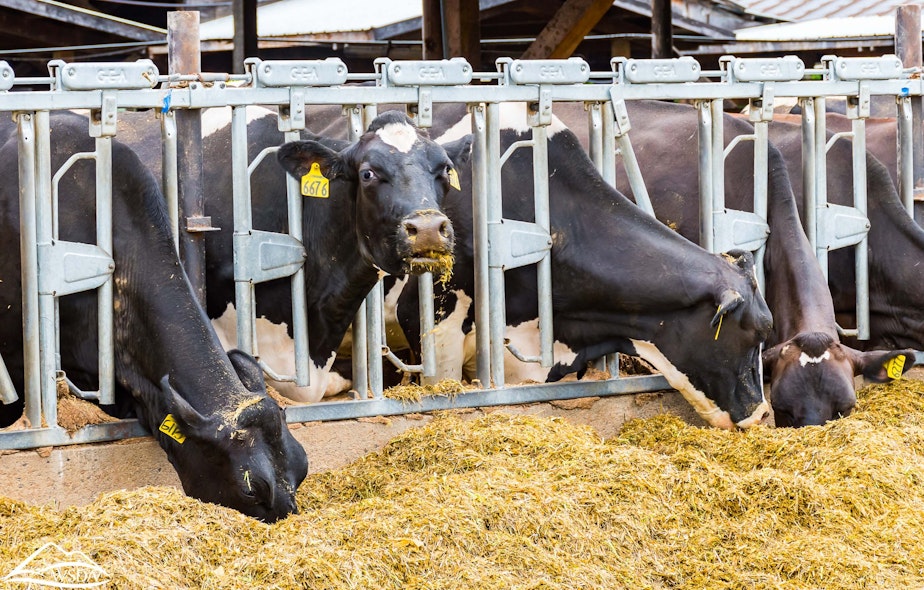Bird flu is now spreading to cattle. Should Washington dairy farmers be worried?

As of last week, a long-running avian influenzas outbreak has affected more than 85 million poultry birds, making it the deadliest avian flu epidemic in U.S. history. If that wasn’t enough cause for concern, cases of avian flu are now showing up in dairy cows and in Texas, at least one case was confirmed to have jumped from a dairy cow to a person.
Washington sits on path called the Pacific Flyway, which brings millions of birds to the state as they migrate. As the avian flu spreads, that migration brings a lot of exposure to local birds and animals — and their interaction with cows, specifically, is more often than you might think.
"Birds really enjoy a little bit of extra corn or a little bit of supplement or a little bit of grain out of those feed bunks that cattle eat out of," said Anna King, who covers Washington and Oregon, mainly east of the mountains, for the Northwest News Network. "It's very difficult to keep birds out of barns, and so they just come for the free meals."
Elsewhere in the United States, dairy cattle are contracting avian flu, and officials aren't yet certain how the virus itself is transmitting across species. While avian flu can be devastating to birds, who become lethargic and tired, it's less damaging to cattle.
"Milk production is kind of a really good bellwether of how the cow is feeling. If the cow is feeling relaxed and calm and happy, it'll produce a lot of milk," King said. "But if the cow feels sick or unwell, or is hurt in some way, milk production goes way down. And that's what's happening with the avian influenza in the cattle."
Cows with avian flu lose their appetite and produce a sticky, colostrum-like milk. Cattle who contract the virus are taken off the milking string, and their milk is dumped to prevent spread. There is a particular concern that the machines used to milk could be a vector for avian flu, and machines are cleaned before reuse.
Sponsored
As for animals that may have been milked without the virus being detected, the pasteurization process has proven to kill avian flu present in milk.
"So there's no worry about your cereal milk, or what you're putting in your coffee," King said.
Avian flu has been confirmed in 26 herds across eight states. Washington and Oregon do not currently have any confirmed cases of avian flu in cattle, but with bird migration season, local farmers are making preparations for safeguarding their herds. Biosecurity plans include putting up decoy coyotes and wolves in fields to scare off birds, using speakers with hawk calls, and pumping standing water near cattle.
Scientists are learning more about newer strains of avian flu as they develop. Kevin Snekvik, executive director of the Washington Animal Disease Diagnostic Laboratory at Washington State University, said avian flu has jumped to other animals before, such as skunks and raccoons, but so far, they're unsure how it ended up infecting dairy cows.
"The idea is that they're scavenging on that bird carcass, and then they get a high dose of the virus, which then spreads into them and causes disease in cattle," Snekvik said.
Sponsored
But there is concern for more than just animal-to-animal vectors. Human transmission is also of concern. In 2022 a human contracted avian flu working at a poultry farm in Colorado, with a recent case developing at a dairy farm in Texas, the first known case of avian flu jumping from another mammal to a person.
So far, symptoms appear to be relatively mild.
"Very mild signs from conjunctivitis (meaning redness of the eyes), that sort of thing. Very, very minimal disease," Snekvik said. "And then as far as the risk, what we're seeing is that the virus is not picking up mutations that would suggest that it's more virulent in mammals or in people are being a risk to people. At this point in time, people have been working quite hard on sequencing these new viruses that are coming out on the cattle to evaluate the risks there."
The Centers for Disease Control and Prevention has warned doctors to watch out for patients who present with these symptoms after working with animals. The agency's website stresses that occasional sporadic human infections with H5N1 viruses do not change the human risk assessment to the general public, which CDC considers to be low.
Listen to the full Soundside segment by clicking "play" on the audio icon at the top of this story.






